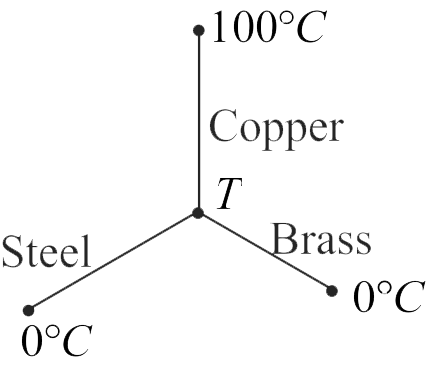366416
Three rods of copper, brass and steel are welded together to form an inverted \(Y\)-shaped structure. End of copper rod is maintained at \(100^\circ C\) whereas ends of brass and steel are kept at \(0^\circ C.\) All the three rods have same length of \(9\;cm\) and cross section of \(4.5\;c{m^2}.\) The rods are thermally insulated from surroundings except at ends. Rate of heat flow through copper rod is
(Take thermal conductivities of copper, brass and steel to be \(0.9,0.24\) and 0.11 \(CGS\) units respectively.)
366417 The container \(A\) is constantly maintained at\(100^\circ C\) and container \(B\) contains ice at \(0^\circ C\). Different rods are used to connect them. For a rod made of copper, it takes 30 minutes for the ice to melt and for a rod of steel of same crosssection taken in different experiment it takes 60 minutes for ice to melt. When these rods are simultaneously connected in parallel, the ice melts in:
366418
A thin brass sheet at \(10^\circ C\) and thin steel at \(20^\circ C\) have the same surface area. The common temperature at which both would have the same area (coefficient of linear expansion for brass and steel are respectively
\((19 \times {10^{ - 6}}/^\circ C\) and \(11 \times {10^{ - 6}}/^\circ C\) )
366416
Three rods of copper, brass and steel are welded together to form an inverted \(Y\)-shaped structure. End of copper rod is maintained at \(100^\circ C\) whereas ends of brass and steel are kept at \(0^\circ C.\) All the three rods have same length of \(9\;cm\) and cross section of \(4.5\;c{m^2}.\) The rods are thermally insulated from surroundings except at ends. Rate of heat flow through copper rod is
(Take thermal conductivities of copper, brass and steel to be \(0.9,0.24\) and 0.11 \(CGS\) units respectively.)
366417 The container \(A\) is constantly maintained at\(100^\circ C\) and container \(B\) contains ice at \(0^\circ C\). Different rods are used to connect them. For a rod made of copper, it takes 30 minutes for the ice to melt and for a rod of steel of same crosssection taken in different experiment it takes 60 minutes for ice to melt. When these rods are simultaneously connected in parallel, the ice melts in:
366418
A thin brass sheet at \(10^\circ C\) and thin steel at \(20^\circ C\) have the same surface area. The common temperature at which both would have the same area (coefficient of linear expansion for brass and steel are respectively
\((19 \times {10^{ - 6}}/^\circ C\) and \(11 \times {10^{ - 6}}/^\circ C\) )
366416
Three rods of copper, brass and steel are welded together to form an inverted \(Y\)-shaped structure. End of copper rod is maintained at \(100^\circ C\) whereas ends of brass and steel are kept at \(0^\circ C.\) All the three rods have same length of \(9\;cm\) and cross section of \(4.5\;c{m^2}.\) The rods are thermally insulated from surroundings except at ends. Rate of heat flow through copper rod is
(Take thermal conductivities of copper, brass and steel to be \(0.9,0.24\) and 0.11 \(CGS\) units respectively.)
366417 The container \(A\) is constantly maintained at\(100^\circ C\) and container \(B\) contains ice at \(0^\circ C\). Different rods are used to connect them. For a rod made of copper, it takes 30 minutes for the ice to melt and for a rod of steel of same crosssection taken in different experiment it takes 60 minutes for ice to melt. When these rods are simultaneously connected in parallel, the ice melts in:
366418
A thin brass sheet at \(10^\circ C\) and thin steel at \(20^\circ C\) have the same surface area. The common temperature at which both would have the same area (coefficient of linear expansion for brass and steel are respectively
\((19 \times {10^{ - 6}}/^\circ C\) and \(11 \times {10^{ - 6}}/^\circ C\) )
366416
Three rods of copper, brass and steel are welded together to form an inverted \(Y\)-shaped structure. End of copper rod is maintained at \(100^\circ C\) whereas ends of brass and steel are kept at \(0^\circ C.\) All the three rods have same length of \(9\;cm\) and cross section of \(4.5\;c{m^2}.\) The rods are thermally insulated from surroundings except at ends. Rate of heat flow through copper rod is
(Take thermal conductivities of copper, brass and steel to be \(0.9,0.24\) and 0.11 \(CGS\) units respectively.)
366417 The container \(A\) is constantly maintained at\(100^\circ C\) and container \(B\) contains ice at \(0^\circ C\). Different rods are used to connect them. For a rod made of copper, it takes 30 minutes for the ice to melt and for a rod of steel of same crosssection taken in different experiment it takes 60 minutes for ice to melt. When these rods are simultaneously connected in parallel, the ice melts in:
366418
A thin brass sheet at \(10^\circ C\) and thin steel at \(20^\circ C\) have the same surface area. The common temperature at which both would have the same area (coefficient of linear expansion for brass and steel are respectively
\((19 \times {10^{ - 6}}/^\circ C\) and \(11 \times {10^{ - 6}}/^\circ C\) )
